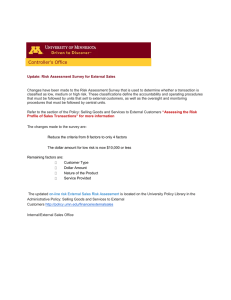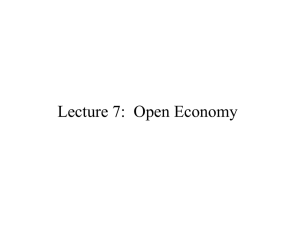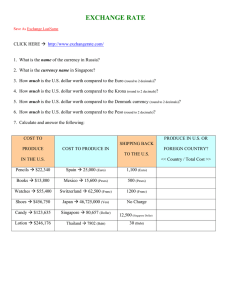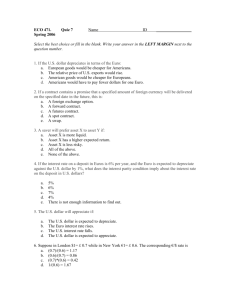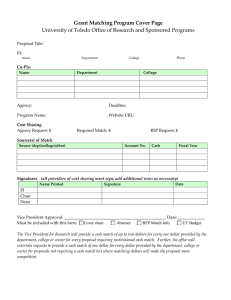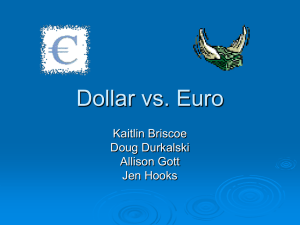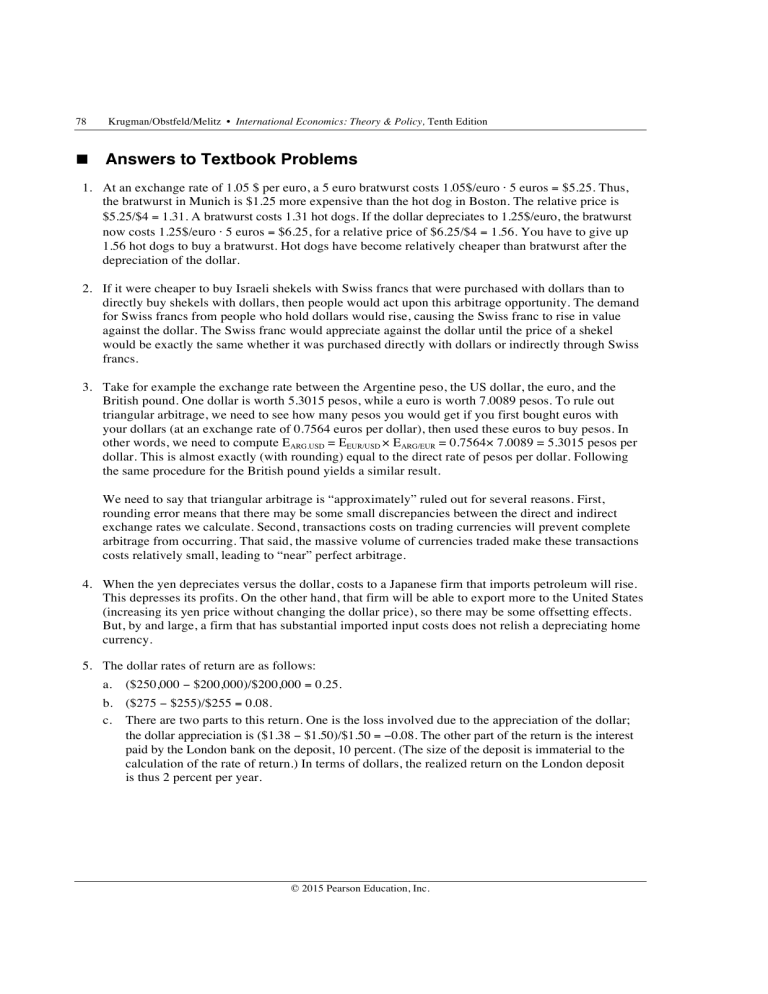
78 Krugman/Obstfeld/Melitz • International Economics: Theory & Policy, Tenth Edition n Answers to Textbook Problems 1. At an exchange rate of 1.05 $ per euro, a 5 euro bratwurst costs 1.05$/euro ⋅ 5 euros = $5.25. Thus, the bratwurst in Munich is $1.25 more expensive than the hot dog in Boston. The relative price is $5.25/$4 = 1.31. A bratwurst costs 1.31 hot dogs. If the dollar depreciates to 1.25$/euro, the bratwurst now costs 1.25$/euro ⋅ 5 euros = $6.25, for a relative price of $6.25/$4 = 1.56. You have to give up 1.56 hot dogs to buy a bratwurst. Hot dogs have become relatively cheaper than bratwurst after the depreciation of the dollar. 2. If it were cheaper to buy Israeli shekels with Swiss francs that were purchased with dollars than to directly buy shekels with dollars, then people would act upon this arbitrage opportunity. The demand for Swiss francs from people who hold dollars would rise, causing the Swiss franc to rise in value against the dollar. The Swiss franc would appreciate against the dollar until the price of a shekel would be exactly the same whether it was purchased directly with dollars or indirectly through Swiss francs. 3. Take for example the exchange rate between the Argentine peso, the US dollar, the euro, and the British pound. One dollar is worth 5.3015 pesos, while a euro is worth 7.0089 pesos. To rule out triangular arbitrage, we need to see how many pesos you would get if you first bought euros with your dollars (at an exchange rate of 0.7564 euros per dollar), then used these euros to buy pesos. In other words, we need to compute EARG.USD = EEUR/USD × EARG/EUR = 0.7564× 7.0089 = 5.3015 pesos per dollar. This is almost exactly (with rounding) equal to the direct rate of pesos per dollar. Following the same procedure for the British pound yields a similar result. We need to say that triangular arbitrage is “approximately” ruled out for several reasons. First, rounding error means that there may be some small discrepancies between the direct and indirect exchange rates we calculate. Second, transactions costs on trading currencies will prevent complete arbitrage from occurring. That said, the massive volume of currencies traded make these transactions costs relatively small, leading to “near” perfect arbitrage. 4. When the yen depreciates versus the dollar, costs to a Japanese firm that imports petroleum will rise. This depresses its profits. On the other hand, that firm will be able to export more to the United States (increasing its yen price without changing the dollar price), so there may be some offsetting effects. But, by and large, a firm that has substantial imported input costs does not relish a depreciating home currency. 5. The dollar rates of return are as follows: a. ($250,000 − $200,000)/$200,000 = 0.25. b. ($275 − $255)/$255 = 0.08. c. There are two parts to this return. One is the loss involved due to the appreciation of the dollar; the dollar appreciation is ($1.38 − $1.50)/$1.50 = −0.08. The other part of the return is the interest paid by the London bank on the deposit, 10 percent. (The size of the deposit is immaterial to the calculation of the rate of return.) In terms of dollars, the realized return on the London deposit is thus 2 percent per year. © 2015 Pearson Education, Inc. Chapter 14 Exchange Rates and the Foreign Exchange Market: An Asset Approach 79 6. Note here that the ordering of the returns of the three assets is the same whether we calculate real or nominal returns. a. The real return on the house would be 25 percent − 10 percent = 15 percent. This return could also be calculated by first finding the portion of the $50,000 nominal increase in the house’s price due to inflation ($20,000), then finding the portion of the nominal increase due to real appreciation ($30,000), and finally finding the appropriate real rate of return ($30,000/$200,000 = 0.15). b. Again, subtracting the inflation rate from the nominal return, we get 8 percent − 10 percent = −2 percent. c. 2 percent − 10 percent = −8 percent. 7. The current equilibrium exchange rate must equal its expected future level since, with equality of nominal interest rates, there can be no expected increase or decrease in the dollar/pound exchange rate in equilibrium. If the expected exchange rate remains at $1.52 per pound and the pound interest rate rises to 10 percent (5 percent higher than U.S. interest rates), then interest parity is satisfied only if the current exchange rate changes such that there is an expected appreciation of the dollar equal to 5 percent. This will occur when the exchange rate rises to $1.60 per pound (a depreciation of the dollar against the pound). 8. If market traders learn that the dollar interest rate will soon fall, they also revise upward their expectation of the dollar’s future depreciation in the foreign exchange market. Given the current exchange rate e and interest rates, there is thus a rise in the expected dollar return on euro deposits from REU,1 to e REU,2 . At the current exchange rate of E1, the dollar return on a European asset exceeds the dollar return on a U.S. asset. As investors shift their money into European assets, the dollar will depreciate against the euro. This will drive down the dollar return on European assets until interest rate parity is restored at the new exchange rate E2. 9. The analysis will be parallel to that in the text. As shown in the accompanying diagrams, a movement down the vertical axis in the new graph, however, is interpreted as a euro appreciation and dollar depreciation rather than the reverse. Also, the horizontal axis now measures the euro interest rate. © 2015 Pearson Education, Inc. 80 Krugman/Obstfeld/Melitz • International Economics: Theory & Policy, Tenth Edition The two diagrams below show the effects of an increase in European interest rates and an increase in the expected future exchange rate in terms of euros per dollar. In the first case, an increase in European interest rates raises the euro return on a European asset above the euro return on an American asset. This will cause the exchange rate to fall (euro appreciation, dollar depreciation) from E1 to E2. In the second case, the expected appreciation of the dollar raises the euro return on an American asset e e from RUS,1 to RUS,2 . At the current exchange rate, American assets pay a higher euro return and the exchange rate must rise (euro depreciation, dollar appreciation) to restore interest rate parity. 10. a. If the Federal Reserve pushed interest rates down, with an unchanged expected future exchange rate, the dollar would depreciate (note that the article uses the term “downward pressure” to mean pressure for the dollar to depreciate). If there is a “soft landing,” and the Federal Reserve does not lower interest rates, then this dollar depreciation will not occur. b. The “disruptive” effects of a recession make dollar holdings more risky. Risky assets must offer some extra compensation such that people willingly hold them as opposed to other, less risky assets. This extra compensation may be in the form of a bigger expected appreciation of the currency in which the asset is held. Given the expected future value of the exchange rate, a bigger expected appreciation is obtained by a more depreciated exchange rate today. Thus, a recession that is disruptive and makes dollar assets more risky will cause a depreciation of the dollar. 11. The euro is less risky for you. When the rest of your wealth falls, the euro tends to appreciate, cushioning your losses by giving you a relatively high payoff in terms of dollars. Losses on your euro assets, on the other hand, tend to occur when they are least painful, that is, when the rest of your wealth is unexpectedly high. Holding the euro, therefore, reduces the variability of your total wealth. 12. The chapter states that most foreign exchange transactions between banks (which accounts for the vast majority of foreign exchange transactions) involve exchanges of foreign currencies for U.S. dollars, even when the ultimate transaction involves the sale of one nondollar currency for another nondollar currency. This central role of the dollar makes it a vehicle currency in international transactions. The reason the dollar serves as a vehicle currency is that it is the most liquid of currencies because it is easy to find people willing to trade foreign currencies for dollars. The greater liquidity of the dollar as compared to, say, the Mexican peso, means that people are more willing to hold the dollar than the peso, and thus, dollar deposits can offer a lower interest rate, for any expected rate of depreciation against a third currency, than peso deposits for the same rate of depreciation against that third currency. As the world capital market becomes increasingly integrated, the liquidity advantages of holding dollar deposits as opposed to euro deposits will probably diminish. The euro represents an economy as large as the United States, so it is possible that it will assume some of that vehicle role of the dollar, reducing the liquidity advantages to as far as zero. When it was first introduced in 1999, the euro had © 2015 Pearson Education, Inc. Chapter 14 Exchange Rates and the Foreign Exchange Market: An Asset Approach 81 no history as a currency, though, so some investors may have been leery of holding it until it established a track record. As the euro has become more established, though, the liquidity advantage of the dollar should be fading (albeit slowly). 13. The interest rate parity condition tells us that interest rates and exchange rates are directly linked. As interest rates become more volatile, so too will exchange rates. For example, suppose that the European Central Bank actively limits fluctuations in euro interest rates while the Federal Reserve does not intervene to keep dollar interest rates stable. Interest rate parity states that: RUS − REU = (E$/e € − E$/ € )/E$/ € If the left-hand side of this equation becomes more volatile, then so too must the right-hand side. Assuming that expectations remain unchanged, then this increase in volatility will be reflected in higher variablility of the exchange rate. 14. A tax on interest earnings and capital gains leaves the interest parity condition the same because all its components are multiplied by one less the tax rate to obtain after-tax returns. If capital gains are untaxed, the expected depreciation term in the interest parity condition must be divided by 1 less the tax rate. The component of the foreign return due to capital gains is now valued more highly than interest payments because it is untaxed. 15. The forward premium can be calculated as described in the Appendix. In this case, we find the forward premium on euro to be (1.26 − 1.20)/1.20 = 0.05. The interest rate difference between one-year dollar deposits and one-year euro deposits will be 5 percent because the interest difference must equal the forward premium on euro against dollars when covered interest parity holds. 16. The value should have gone down as there is no more need to engage in intra-EU foreign currency trading. This represents the predicted transaction cost savings stemming from the euro. At the same time, the importance of the euro as an international currency may have generated more trading in euros as more investors (from central banks to individual investors) choose to hold their funds in euros or denominate transactions in euros. On net, though, we would expect the value of foreign exchange trading in euros to be less than the sum of the previous currencies. 17. If the dollar depreciated, all else being equal, we would expect outsourcing to diminish. If, as the problem states, much of the outsourcing is an attempt to move production to locations that are relatively cheaper, then the United States becomes relatively cheap when the dollar depreciates. Although it may not be as cheap a destination as some other locations, at the margin, labor costs in the United States will have become relatively cheaper, making some firms choose to retain production at home. For example, we could say that the labor costs of producing a computer in Malaysia is $220 and the extra transport cost is $50, but the U.S. costs were $300; then we would expect the firm to outsource. On the other hand, if the dollar depreciated 20 percent against the Malaysian ringitt, the labor costs in Malaysia would now be $264 (that is, 20 percent higher in dollar terms, but unchanged in local currency). This, plus the transport costs, makes production in Malaysia more expensive than in the United States, making outsourcing a less attractive option. © 2015 Pearson Education, Inc. 82 Krugman/Obstfeld/Melitz • International Economics: Theory & Policy, Tenth Edition 18. They key here is to compute the return on the carry trade by accounting for not only the difference between Korean and American interest rates, but also the percentage change in the value of the Korean won against the dollar. The risk of the carry trade is that the won might depreciate against the dollar, thus negating the higher interest rate paid on Korean bonds. Using data from Jan 2009 through Oct 2013, a carry trade described in this problem would have the following cumulative return: 19. As per the question, a currency depreciation benefits exporters and hurts consumers by raising the cost of living. Exporters tend to have more influence with the government for two reasons. First, there are fewer exporters than there are consumers, so the gains from a currency depreciation are much more heavily concentrated than the losses. As a result, each individual exporter will put forth more effort in lobbying the government than each individual consumer. Second, exporters are much easier to organize and coordinate than are a disparate mass of consumers. There are effective enforcement mechanisms in place to ensure that all exporters contribute to get a government to depreciate the currency, thus reducing the risk of free riding. Consumers will have a much harder time coordinating their lobbying efforts because there is no effective way to ensure that every consumer contributes toward such an effort. The risk of free riding is much higher among consumers. © 2015 Pearson Education, Inc.
